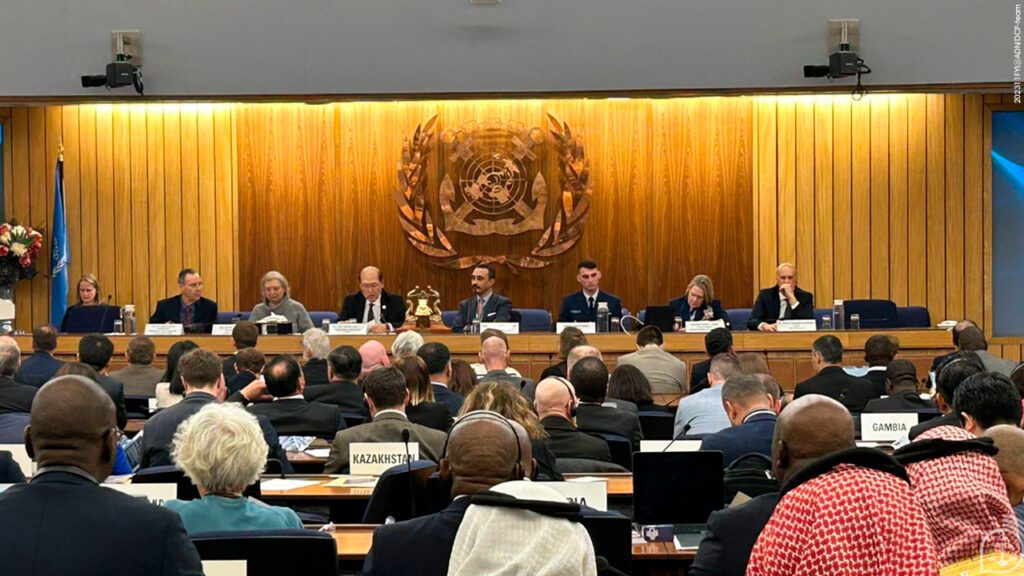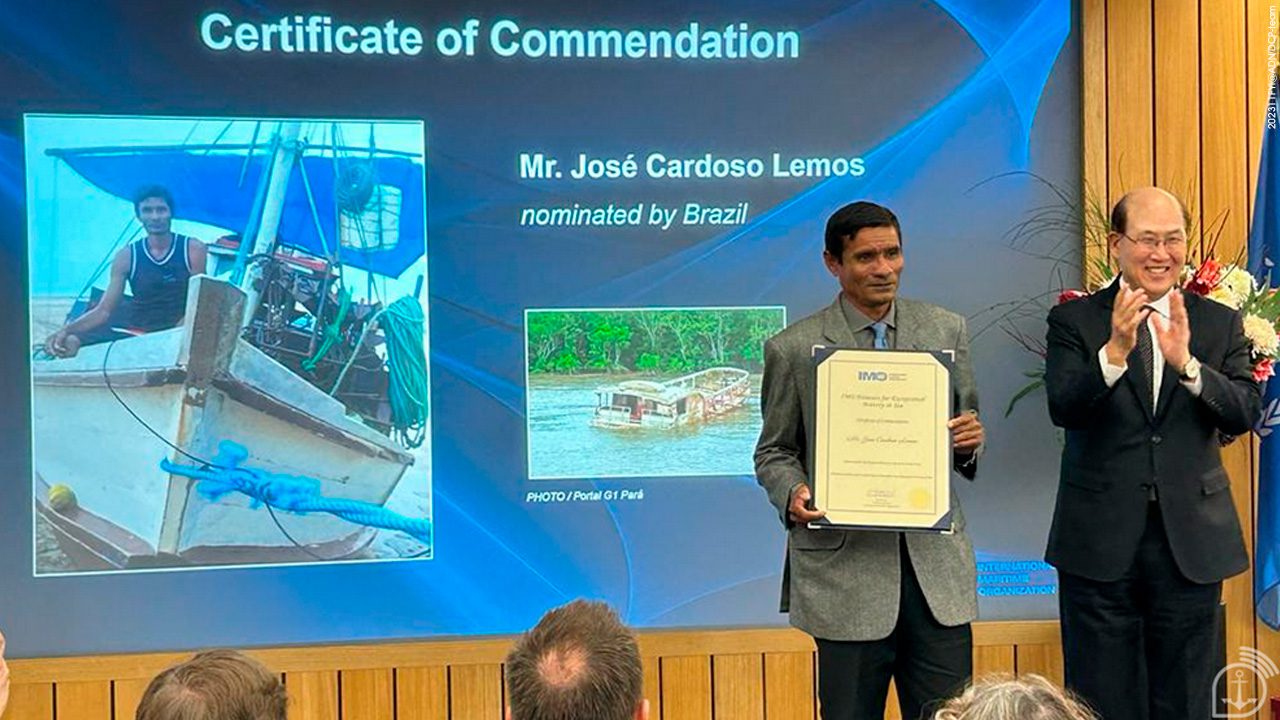Certificate of Commendation was presented at the Organization’s headquarters in London
By First Lieutenant (RM2-T) Kizia Fonsêca – London, United Kingdom
On Monday (27), Brazil was present at one of the most prestigious awards for the world maritime community, the IMO Award for Outstanding Bravery at Sea, from the International Maritime Organization (IMO). The event took place at the Organization’s headquarters in London. One of the recipients of the Certificate of Commendation for his act of bravery was fisherman José Cardoso Lemos, 48. He rescued 35 people alive from a boat that had sunk near Cotijuba Island, in the state of Pará.
A member of the IMO’s Consultative Council since 1967, Brazil has been active through its Permanent Representation, exercised by the Brazilian Navy, contributing to the development of international regulations related to the Organization’s attributions, especially those concerning the safety of navigation and the protection of the marine environment.
In this context, one of the activities to raise awareness of the issues at stake are the awards for activities carried out in the international maritime sector. These include the “IMO Honors for Exceptional Bravery at Sea”, which are awarded annually and were established to provide international recognition to those who, at the risk of losing their lives, perform acts of exceptional bravery, showing extraordinary courage in trying to save lives at sea or in trying to prevent or mitigate damage to the marine environment. Such acts of bravery can also involve extraordinary navigational skills in very difficult conditions or any other display of extraordinary courage.
Every year, the IMO receives nominations from its member countries and institutions of people who have performed acts of bravery. There are three types of award categories: the first is the prize awarded for the most outstanding act of bravery among those described. The second category awards the participant a Certificate of Commendation when they are recognized for acts of extraordinary bravery. The third category sends letters of commendation to participants deemed worthy of special recognition for meritorious actions they have carried out in the current year. In the 2023 edition, the IMO received 47 nominations from 18 countries, one association and three Non-Governmental Organizations, all active members.
After careful consideration, the Panel of Judges agreed that the first category, the IMO Award for Outstanding Bravery at Sea 2023, should be awarded to Aviation Survival Technician Second Class Caleb Halle, from Coast Guard Air Station Atlantic City, United States of America (USA). He was nominated by the North American country for his remarkable courage, endurance and determination in rescuing the seven crew members of Legacy, a craft that was adrift in bad weather and rough seas.
In the second category, the Panel of Judges agreed that 4 nominations should receive a Certificate of Commendation for their acts of bravery. The member countries chosen for this category were Australia, Brazil, China and the USA. Brazil was represented in this category by José Cardoso Lemos.

About the rescue
On September 8, 2022, at around 8 a.m., José was preparing to go to work with his son and nephew near Cotijuba Island, in the state of Pará, when he was told by another fisherman that a regional passenger boat had sunk near his position.
He immediately set off with his boat and, when he arrived at the scene of the accident, where the boat “Dona Lourdes II” sank, he was confronted with the saddest scene of his life: “It looked like a scene from a horror movie, there were about 80 people screaming for help in the water, the vast majority of them old women, totally desperate. It was horrible,” said the fisherman. He immediately began the rescue procedure as best he could, putting the castaways into his boat. “People were crammed into larger buoys, others were clinging to the seats of the boat, hoping to float. The first buoy had 16 people on it, while the second had around 23,” recalled the fisherman, his eyes watering.
In order to increase the space on his boat to accommodate as many people as possible, José threw all his fishing equipment into the water. As it was a small boat, the fisherman made two trips, disembarking the victims at Praia da Saudade, where ambulances and the local population were providing first aid.
He tried to make a third trip, but unfortunately, when he returned to the rescue site, he found the rest of the victims lifeless. He recalls that there was a child, aged 5, who was with his grandmother making the journey in the boat that sank. After a tearful pause, José said that the child cried out in sobs for him to come back and rescue her guardian. Having found her lifeless on the third trip, he immediately set about rescuing the bodies at the scene. In all, he rescued 35 people alive and 9 bodies.
The son of a fisherman, José started fishing as a child, at the age of 12. A simple and determined man, he was faced with an extreme situation and bravely performed the virtues of a sailor. Initiative, a spirit of sacrifice, selflessness, tenacity and courage were present at all times that September morning. He never thought it would happen to him until it did.
A few years ago, José suffered an accident on a boat, which is why he spent more than a month in intensive care. The episode left physical motor sequelae, with 50% loss of movement on the left side of his body. However, his physical condition did not prevent him from working in the rescue sector, despite the economic damage it caused him, leaving behind equipment that had been bought over a lifetime for his work, in order to increase the space for the rescue on the day of the accident.
Today, when he enters the boat he uses every day to make a living, José gets emotional: “Every corner I look at has a memory. When I close my eyes, I see the child crying for his grandmother, I remember the bodies in the bow, the screams. It wasn’t an easy day.
When asked what his attitude would be if an accident happened again, he smiles and replies: “I’d do everything the same, I’d try to help even more. The accident changed my life and I’m sure I’ve helped a lot of people. I’m not a hero, I’m just an ordinary man who did what he thought was right”.
This is the third time that Brazil has won an award at the IMO. The other two were in 2008 and 2020. “I never thought that one day I would leave the country to receive an award for doing what I thought was right, for helping people. I’d like to thank the Brazilian Navy for helping me achieve this recognition,” says José.

Waterway Traffic Safety
Still on the subject of the accident, José stressed the importance of raising awareness about navigation safety and the need for the Brazilian Navy (MB) to act in the region: “During the rescue, I realized that many people were wearing life jackets the wrong way round. Many people were fastening the vest with the whistle cord, tying it around their waist, which is not how the Navy teaches us to use it.”
A MB tem atuado constantemente na fiscalização e conscientização da Segurança do Tráfego Aquaviário na região. Segundo o Capitão dos Portos da Amazônia Oriental, Ewerton Rodrigues Calfa, “é necessário que prestadores de serviço e usuários entendam a importância dessas medidas de segurança, a fim de evitar acidentes como o naufrágio da ‘Dona Lourdes II’”. Ainda sobre atuação da MB: “A Marinha faz a fiscalização 24 horas por dia, 365 dias por ano. Tão importante quanto a fiscalização, é a conscientização. A Marinha também trabalha com palestras, orientações diretas, instalações de cobertura de eixo, que servem para combater acidentes de escalpelamento, quando oportuno distribuímos coletes salva-vidas, isso tudo é feito para que se crie uma conscientização maior de usuários e prestadores de serviços.”, explicou.
Segundo o Capitão dos Portos, ainda existe muita desinformação por parte da população sobre como se deve usar o colete salva-vidas, que precisa estar em um bom estado de conservação e na validade. “Se você está em uma embarcação de transporte de passageiros, a tripulação deve fazer uma demonstração de como vestir e utilizar corretamente o colete salva-vidas. Nada muito diferente do que a gente consegue acompanhar, por exemplo, dentro dos aviões”, disse.
Source: Agência Marinha de Notícias *** Translated by DEFCONPress FYI Team ***
